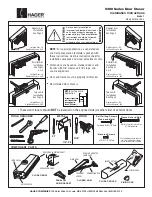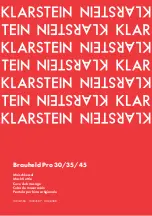
12
Table 3. Pipe Length Selection Chart
Type of
Pipe
Black Iron
Pipe for
20’
_
60’
100’
Natural Gas
Aluminum or
Copper Tubing*
10’
_
30’
_
for Natural Gas
Aluminum or
Copper Tubing
_
40’
100’
_
for LP Gas
*Copper tubing should be internally tin coated.
1/2"
5/8"
3/4"
1"
Maximum Possible Pipe
Length Required for Different
Pipe Diameters
in H.U.D. Standard Part 3280.103 (b) (2). These
packages introduce outdoor air into the living
space during furnace blower operation. The
VentilAire IV also serves to exhaust moist and/
or hot air from the attic space. See Figures 10
and 11 for typical installation. Complete
installation instructions are supplied with each
air quality package.
FUEL CONNECTIONS
Gas Piping Requirements - PG Series Only
Gas piping should be sized and installed in
accordance with local codes ANSI Z223.1/
NFPA 54 (National Fuel Gas Code) and utility
regulations. To install the gas supply piping,
connect a separate gas line from the gas meter
to the burner with a manual shut-off valve
installed in the line at the furnace. This valve
should be readily accessible to shut-off the gas
supply to the furnace in case of an emergency
shutdown. When installing the gas supply line,
always use new clean piping and route the line
in such a manner as to be easily accessible.
The piping and threading must be free from
cutting burrs and defects. The line must be
durable, substantial, and gas tight. Installing a
tee fitting with a sediment trap at the bottom of
the riser to catch any foreign debris in the gas
supply line is recommended. An additional main
manual shut-off valve may be installed in the
gas supply line to shut-off the main fuel supply,
if desired by the homeowner or required by local
codes.
The proper gas supply line size can be
determined using the gas piping chart, shown
in Table 3. Black pipe is the most practical for
natural gas, because of the larger sizes required.
Copper tubing with an internal coating of tin is
recommended for use with propane (LP) gas
installations. Compounds used on the threaded
joints must be resistant to the actions of propane
(LP) gases.
Carefully check for gas leaks with a soap
solution or a commercial leak detector fluid.
NEVER USE A MATCH OR OPEN FLAME TO
DETECT A GAS LEAK!
!
CAUTION:
The furnace and its appliance main gas
valve must be disconnected from the gas
supply piping system during any pres-
sure testing of that system at test pres-
sures in excess of ½ psi (3.5 kPa). The
furnace must be isolated from the gas
supply piping system by closing the equip-
ment shut-off valve during any pressure
testing of the gas supply piping system at
test pressures equal to or less than ½ psi
(3.5 kPa).
Oil Piping Installation — PO Series Only
The following procedures are recommended
as good practice. However, requirements of
local codes and ordinances, H.U.D. Manufac-
tured Home and Safety Standards or National
Fire Protection Association must be satisfied,
where they apply, for an approved installation.
Use a tank capacity suitable for the application
with a weatherproof, capped fill opening and a
shielded vent to let in air as fuel is used. The tank
must be clean inside before filling. All water,
rust, sediment, and other foreign matter must
be flushed out.
If a two pipe system is used or if oil is taken from
the bottom of the tank, a filter is recommended.
Furthermore, a manual shut-off valve may be
used on a single pipe or two pipe system. Please
note that local codes will dictate the specific
installation requirements.
Summary of Contents for CMF 100-PG
Page 27: ......












































